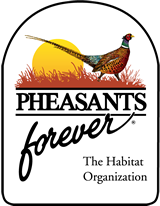
 The Pheasant Habitat Improvement Program, or PHIP, is a joint effort of Pheasants Forever chapters and the Colorado Division of Wildlife to improve pheasant habitat in eastern Colorado. What began in 1992 with a few volunteers from 3 chapters has grown into a program with 11 participating Pheasants Forever Chapters and a phenomenal record of accomplishment. Contributions now come from a cast of hundreds of people: chapter volunteers, landowners, Future Farmer members, Boy Scouts, Explorer Scouts, Soil Conservation Districts, Natural Resource Conservation Districts, and other community groups in addition to Division of Wildlife District Wildlife Managers and biologists.
The Pheasant Habitat Improvement Program, or PHIP, is a joint effort of Pheasants Forever chapters and the Colorado Division of Wildlife to improve pheasant habitat in eastern Colorado. What began in 1992 with a few volunteers from 3 chapters has grown into a program with 11 participating Pheasants Forever Chapters and a phenomenal record of accomplishment. Contributions now come from a cast of hundreds of people: chapter volunteers, landowners, Future Farmer members, Boy Scouts, Explorer Scouts, Soil Conservation Districts, Natural Resource Conservation Districts, and other community groups in addition to Division of Wildlife District Wildlife Managers and biologists.
 Each chapter signs a cooperative agreement with the Division agreeing to improve pheasant habitat in their area following a set of guidelines. The guidelines specify what kinds of habitat, how big plantings can be, types of shrubs or species of grass, reimbursement rates, etc. Chapters then contact landowners to explain the program and discuss the various habitat options. Arrangements are made to prepare the sites for planting, then chapter volunteers either plant the habitat or subcontract with someone to do the work. PHIP cost-share rates are set to cover the costs of habitat plantings; generally there is no cost to landowners.
Each chapter signs a cooperative agreement with the Division agreeing to improve pheasant habitat in their area following a set of guidelines. The guidelines specify what kinds of habitat, how big plantings can be, types of shrubs or species of grass, reimbursement rates, etc. Chapters then contact landowners to explain the program and discuss the various habitat options. Arrangements are made to prepare the sites for planting, then chapter volunteers either plant the habitat or subcontract with someone to do the work. PHIP cost-share rates are set to cover the costs of habitat plantings; generally there is no cost to landowners.
Habitat improvement options are designed to improve pheasant survival, nest success, or both. The most popular option has been 12-row shrub thickets accompanied by 3-row juniper windbreaks on the north and west sides. Over 1,350 of these thicket/windbreak combinations have been planted to date. Plums are most commonly planted in the thicket, and Rocky Mountain junipers in the windbreak, but other species can be used as well. Chapters are increasingly cost sharing on field windbreaks with the NRCS or local Soil Conservation Districts (16 miles planted so far!). Other options for woody plantings include 2-row shrub plantings along creek bottoms (Over 16 miles of these planted!).
 Switchgrass plots are another habitat option gaining in popularity. Switchgrass is a native, warm-season grass that grows tall enough to conceal pheasants and their nests, and has a coarse enough stalk that it remains standing and continues to provide cover in winter when it is needed the most. Switchgrass plots are typically put in small unfarmed areas that are present on many farms. About 1,500 acres at 280 sites have been planted to switchgrass so far.
Switchgrass plots are another habitat option gaining in popularity. Switchgrass is a native, warm-season grass that grows tall enough to conceal pheasants and their nests, and has a coarse enough stalk that it remains standing and continues to provide cover in winter when it is needed the most. Switchgrass plots are typically put in small unfarmed areas that are present on many farms. About 1,500 acres at 280 sites have been planted to switchgrass so far.
Sorghum food plots have proven to be a popular habitat option with pheasants and pheasant hunters alike. Pheasants like them because they provide brood cover in the summer and a dependable food source and good cover in the fall and winter. Hunters like them because harvest surveys conducted by the Division of Wildlife showed their success was 3-4 times higher when hunting food plots than when hunting other cover types. Food plots have typically gone into Conservation Reserve Program (CRP) fields, or in the corners of fields under center-pivot irrigation. A $40/acre payment is available for food plots, and about 600-700 acres are planted each fall.
 More recently, a major initiative has been cost-sharing on grass mixes being planted into CRP fields to encourage landowners to plant grasses that will provide outstanding cover for pheasants and other wildlife. Because of this $5/acre cost-share, over 20,000 acres of CRP have been planted to a pheasant mix containing large percentages of switchgrass and yellow indiangrass. In time, these fields will increase pheasant survival and nest success, and provide high quality hunting cover as well.
More recently, a major initiative has been cost-sharing on grass mixes being planted into CRP fields to encourage landowners to plant grasses that will provide outstanding cover for pheasants and other wildlife. Because of this $5/acre cost-share, over 20,000 acres of CRP have been planted to a pheasant mix containing large percentages of switchgrass and yellow indiangrass. In time, these fields will increase pheasant survival and nest success, and provide high quality hunting cover as well.
Whether you are a landowner looking to improve pheasant habitat, or someone just interested in helping out, the PHIP program may be for you. Contact any Pheasants Forever chapter, or the Division of Wildlife for more information.








